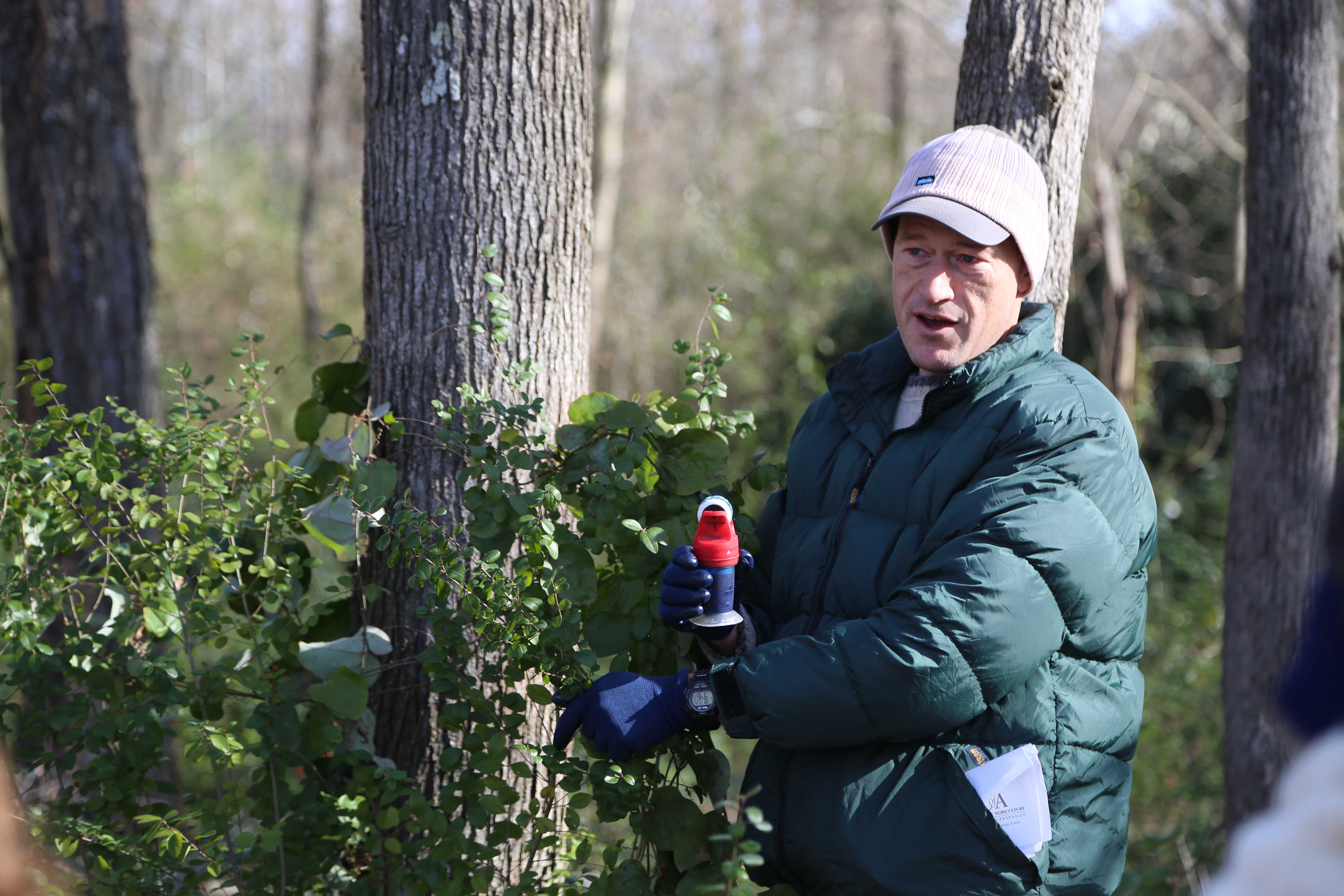Feb. 19, 2020
Volunteers bid adieu to invasive species at weekend ‘privet pull’
By Tracy Courage
U of A System Division of Agriculture
Fast facts
- Chinese privet is an invasive species that damages ecosystems
- Privet can be removed by pulling, herbicide treatments
- Fall to spring best time to remove invasives
To download this story in MS Word format, click here.
(491 words)
(Newsrooms, with additional art at: https://bit.ly/2V4HKd1)
LITTLE ROCK — Despite morning temperatures in the mid 30s, volunteers arrived Feb. 16 at the University of Arkansas System Division of Agriculture’s Cooperative Extension Service, armed with gloves and shears ready to do battle. Their opponent: Chinese privet.

The invasive species is harmful because it chokes out other native plants, affecting native wildlife and water quality.
John Pennington, extension water quality educator, coordinated the Feb. 16 privet pull as part of the Arkansas Watershed Stewards Program to teach people about the impacts of invasive plants on the environmental and water quality and recommended methods of treatment and removal.
Between fall and late spring is an ideal best time to remove privet and other unwanted invasive species, such as nandina, honeysuckle, bamboo and English ivy.
“We don’t have to worry about ticks, and we can see clearly,” Pennington said.
Introduced in the 1900s from China and Europe, Chinese privet (Ligustrum sinense) is a shade-tolerant, tall shrub or tree that can grow up to 30 feet tall. It spreads quickly and replace native underbrush in Arkansas forests.
“Privet is not a host plant for birds and butterflies,” Pennington said.
There are numerous ways to get rid of invasive species from pulling, mowing and cutting the privet to using herbicide treatments. Prescribed burns and grazing also are used in some areas.
While smaller privets can be pulled by hand, older, more established plants are tougher to remove. Pennington brought his Weed Ranch Jr. and PullerBear mechanical pullers for volunteers to try.
Master Gardener Mary VanCura and Randy used the vice-like tools to pry the plants out of the ground.
“It’s hanging in there,” VanCura said. “It’s stubborn.”
Pennington also demonstrated the cut-and-paint method, first cutting the privet down to leave no more than 6 inches of stem. He applied glyphosate using a small paint roller applicator, directly onto the freshly cut stem, no spraying required. A blue dye additive in the herbicide helped volunteers see which stems had been treated.
The volunteers worked in small teams, with one volunteer cutting the privet, another volunteer hauling off the debris, and a third team member applying the herbicide.
The event was educational for both novice and experienced gardeners, including members of the Pulaski County Master Gardeners and the Central Arkansas Master Naturalists who were among the 20 volunteers.
Jeanne De Lanois, a member of the Central Arkansas Master Naturalists and the Arkansas Native Plants Society, attended the privet pull to learn best practices for removing privet from her half-acre of wooded property.
“It was good to see the demonstration and then immediately apply it,” she said.
The volunteers’ work on Saturday contribute to citizen science by establishing invasive plant removal demonstration sites where the effectiveness of treatments will be measured over time., Pennington said.
To learn more about invasive species, visit https://www.uaex.uada.edu/environment-nature/ar-invasives/invasive-plants/
To learn about extension programs in Arkansas, contact your local Cooperative Extension Service agent or visit www.uaex.uada.edu. Follow us on Twitter at @AR_Extension.
About the Division of Agriculture
The University of Arkansas System Division of Agriculture’s mission is to strengthen agriculture, communities, and families by connecting trusted research to the adoption of best practices. Through the Agricultural Experiment Station and the Cooperative Extension Service, the Division of Agriculture conducts research and extension work within the nation’s historic land grant education system.
The Division of Agriculture is one of 20 entities within the University of Arkansas System. It has offices in all 75 counties in Arkansas and faculty on five system campuses.
Pursuant to 7 CFR § 15.3, the University of Arkansas System Division of Agriculture offers all its Extension and Research programs and services (including employment) without regard to race, color, sex, national origin, religion, age, disability, marital or veteran status, genetic information, sexual preference, pregnancy or any other legally protected status, and is an equal opportunity institution.
# # #
Media Contact: Tracy Courage
Director of Communications
U of A Division of Agriculture
Cooperative Extension Service
(501) 671-2126
tcourage@uada.edu